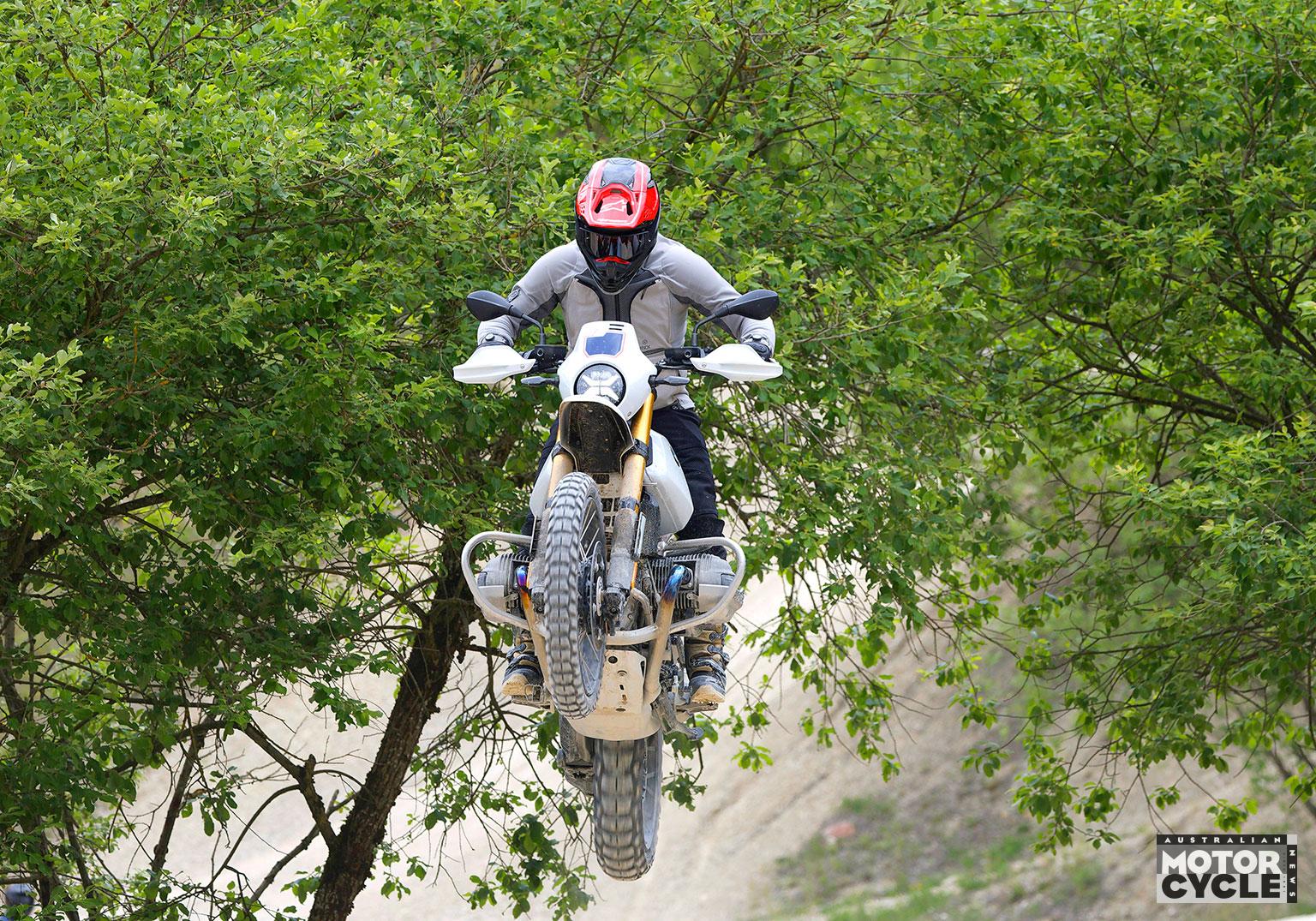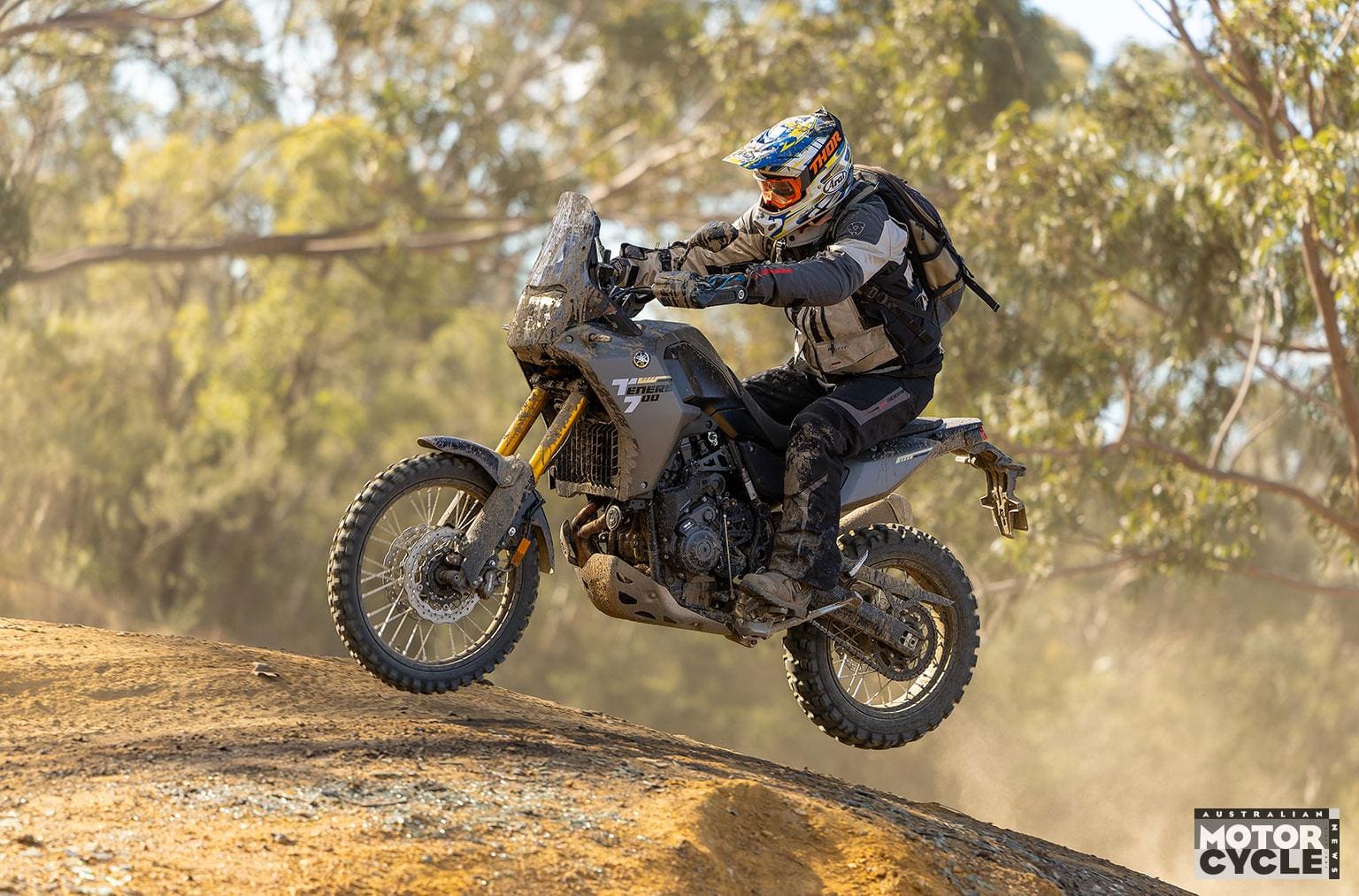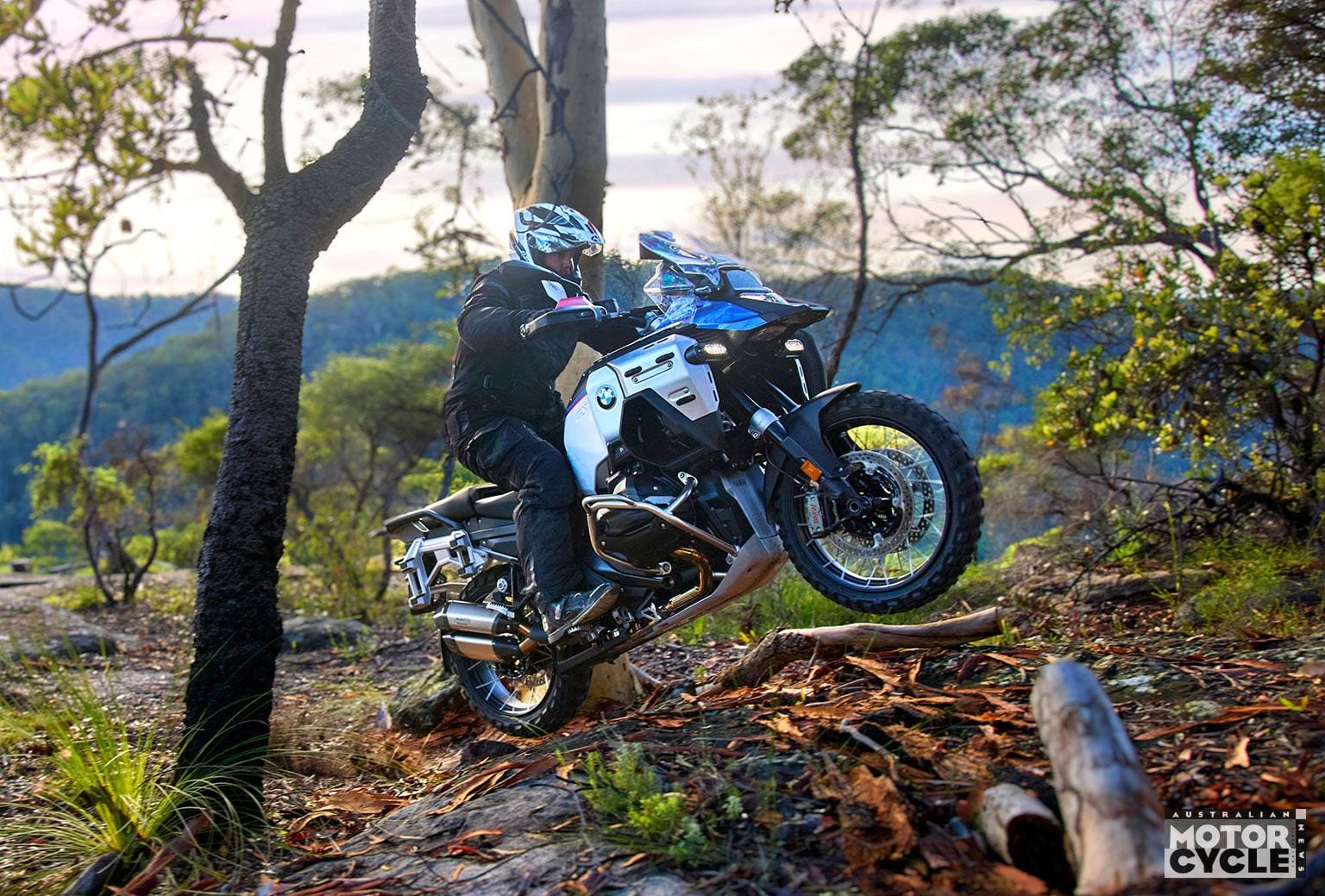More control, boosted efficiency and elevated comfort are all on the menu as Ducati reheats the Multistrada V4S for MY2025
Don’t be tricked. The MY2025 Ducati Multistrada V4 S might look like the current model, but beneath that distinctive and largely unchanged silhouette lies a host of developments that make the Bologna factory’s best-selling adventure-tourer even more efficient and rewarding to ride.
Predictably enough, a raft of electronic updates sits centrestage, all aimed at boosting the versatility of the Multistrada. Ducati Vehicle Observer (DVO), the predictive electronic control system developed by the Ducati Corse MotoGP team and which debuted on the 2024 V4 Panigale, finds its way onboard along with Automatic Lowering Device, which lowers the ride height as the road speed drops to allow better control and more confident stops. Ducati’s electronic boffins have also added a new Wet riding mode, which sits alongside the Touring, Urban, Sport modes as well as an updated Enduro option. There is Engine Brake Control and uprated linked brakes, with the rear lever now also operating the front brake (in addition to the front lever operating the rear). Front-and-rear radar technology, which is carried over on the V4S for 2024 and supports adaptive cruise control and blind spot monitoring, now also supports a new forward-collision warning on the dash.
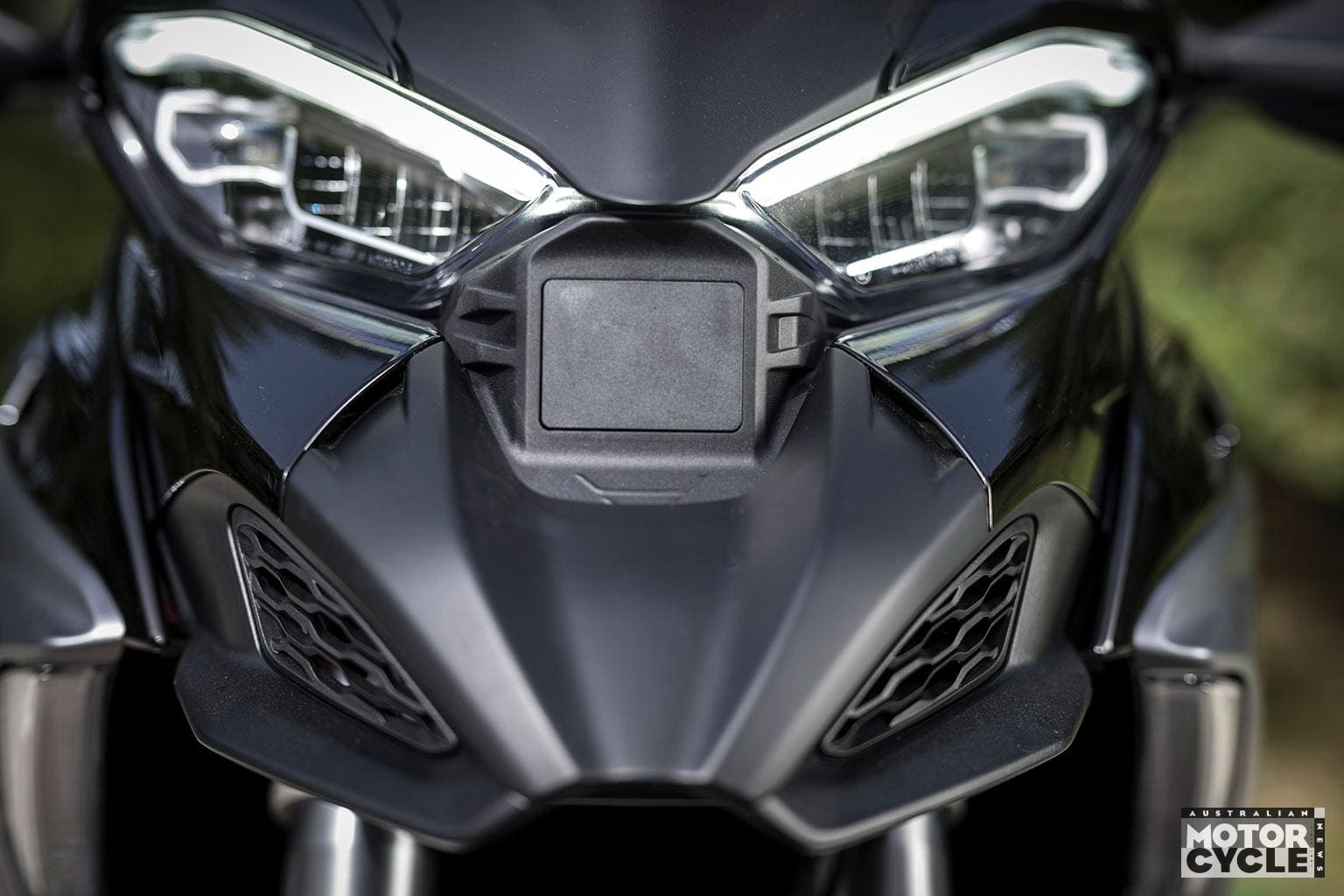
The free-revving and flexible 1158cc Granturismo V4 remains largely untouched, aside from a new exhaust system to comply with Euro5+. With service intervals of 15,000km for an oil change and 60,000km for a valve inspection, and peak power and torque of 127kW (170hp) at 10,750rpm and 123.8Nm at 9000rpm, there was little to improve on here. However, for MY2025, the Multi deactivates its rear bank of cylinders at low speeds as well as when stationery in a bid to further reduce the transfer of engine heat to the rider on warm days (and improve fuel economy).
The Ducati Skyhook Suspension (DSS) semi-active Marzocchi suspension now allows the rider to independently change settings on the move. There are new front fork settings and sensors, while the rear shock has a wider range of spring pre-load settings. The swingarm pivot sits 1mm higher which, according to Ducati, should improve anti-squat, especially with a pillion and luggage onboard. Pillions get more room as the panniers and top box have been moved back, and there is a broad range of optional extras for both rider and pillion. These include seats – high and low, heated or unheated – and five-level heated grips. There are EVO-activated hazard lights and a clear 6.5-inch display with connectivity and even more displayed information, while a fog light is offered as an optional extra.

Two versions to test
Even up close, there’s not much visual difference between the old and new bikes – it’s all subtle tweaks and evolutions – which is a sign of Ducati’s confidence in the Multi. We had two model variants to test: the ‘Ducati Red’, with optional forged wheels, radar system and Pirelli Scorpion Trail II rubber; and the ‘Thrilling Black’, fitted with the adventure travel and radar pack, which includes spoked wheels, aluminium side cases, a centre stand, a heated seat for rider and passenger, heated grips, the radar system and Pirelli Scorpion Rally STR rubber. Essentially, one was biased towards sports touring and the other towards adventure touring.
Short legs and tall adventure bikes have never been the closest of companions, and adjustable ride heights and optional seats have become a new battleground for manufacturers trying to woo all shapes and sizes to their machines. This is great news for the likes of 170cm me. I opted for the standard seat, which can be positioned at 840mm and 860mm, and turned down Ducati’s kind offer of a lower seat option – but it was good to have a choice. Ducati offers not only a lower seat but also a lower suspension kit, which, combined with the low seat, drops you to 795mm – you even get a shorter sidestand.

Crucially for the likes of me, the Multistrada V4 S isn’t physically intimidating. It tops the scales at a manageable 229kg (without fuel) and the Automatic Lowering Device is effective at helping both feet get securely to the ground. This system dials out the suspension’s spring pre-load as the Multi’s speed falls below 10km/h, then re-applies it automatically as speed increases to 50km/h. Alternatively, you can override the system manually and take control yourself. How much the seat height drops depends on the bike’s laden sag. If, for example, you are a heavy rider with a pillion and luggage loaded for a week away, the seat will drop around 30mm. For a lighter solo rider, roughly 15mm would be more normal.
That’s a massive tick – and one which makes the V4 S more accessible than ever. I was also eager to discover if I could feel or hear the rear bank of cylinders deactivate when speeds dropped to below 10km/h or we came to a halt. On Ducati’s Diavel, which trialled the first ECD cut-out system, you can tell by a change to the exhaust and intake noise, but it was less clear-cut on the Multi. All four cylinders should come back online as the revs approach 4000rpm but the precise moment depends on the riding context and amount of torque being requested. If, say, you are running a tall gear at just 2000rpm and grab a handful of throttle, the system will immediately revert to all four cylinders to give you the drive you need. It’s such a smooth transition that I wasn’t always sure whether I was riding a twin or a V4. The only glitch was unseasonably wet and cool weather, which left me unsure how effective the uprated ECD will be on the long, hot rides of summer. We will have to test this further in Australia.

Slick tricks
The damp did give us the chance to test the new Wet riding mode, which limits peak power output to 84Kw (113hp) – that’s down on a full peak of 170hp. Supported by a plethora of lean-sensitive rider aids to keep you safe, and with the Skyhook semi-active suspension set to low-grip conditions, it works supremely well. The laws of physics still apply, of course, but you can exit super-slippery hairpin corners on full throttle – a guaranteed recipe for disaster with lesser electronic systems – and still the bike drives calmly forwards.
As the roads dried out, improved conditions allowed us to sample the new linked Rear to Front braking system. The current V4 S model already runs a Front to Rear system that electronically distributes braking loads between both wheels. Now, for 2025, when in setting ABS 3 and using just the larger-diameter 280mm rear brake, a degree of front brake is also applied. It’s smooth – a million miles from the basic linked systems of the 1990s – and never feels like too much front is being introduced. Exactly how much is dictated by a blend of parameters such as lean angle and speed, but, with your head in laidback touring mode, you can use the rear alone to trim your speed.

Sporting prowess
When you up the pace and begin to exploit the Multi’s ever-present sporting edge, you can feel the ABS trigger under harder braking. At this point you transfer out of Touring mode into Sport mode and ABS setting 2. Now the system reverts to Front to Rear only, with some braking force distributed to the rear when the front lever is applied but the rear no longer has any effect on the front.
Every mod seems to have been designed to make life easier and reduce fatigue in a variety of conditions and scenarios. Sport mode and Touring mode, for example, deliver the same peak power and torque but there is a noticeable difference between their handling characteristics and performance. The gap between the modes appears larger than before: Touring mode runs the bike softer and plusher. The ride and throttle response in Sport mode are by no means harsh but Touring mode has a more forgiving feel to it for 2025. This may in part be down to the repositioned swingarm pivot, the new rear shock or simply the settings – but the revised Touring mode makes the Multi even more capable.

With its fluid and torquey V4 and relatively taut and responsive chassis, the 2025 V4S feels sharper than ever when you select Sports mode, particularly with the new, optional, 2kg-lighter forged wheels fitted. For 2025 Ducati also offers a revamped Multistrada Pikes Peak, complete with 17-inch front wheel, but the all-round and relentlessly versatile V4 S delivers breathless performance on sporty roads. It turns so effortlessly and accurately you could easily be forgiven for thinking that it rides on a 17-inch diameter front wheel and not its class-standard 19-incher.
This potent blend of a flexible engine, a precise chassis and new generation of sophisticated and tuneable rider aids ensures the V4 S thrives in virtually every riding scenario imaginable. It drives hard and snaps into turns as well as it flows and soaks up the miles. You can easily tweak it to your mood. For example, I deactivated the wheelie control because, when the roads allow, I like my bikes to be free to express themselves… But I retained some traction control intervention just in case.

Meanwhile, the up-and-down quickshifter is quick and slick and makes revving the Granturismo north of 10,000rpm as exciting as it is on many pure superbikes. I even played with the changeable engine braking, reducing it to allow the bike to flow a little easier between corners. The only real limitations to all this sportiness are the standard tyres, more so the Pirelli Scorpion Rally STR rubber fitted to the Black Adventure Travel and Radar model. But if you wanted a truly sports-focused Multi, you’d opt for the Pikes Peak and stickier tyres.
On the freeway there’s masses of power, more than enough to shovel rider plus pillion and luggage up to and past the fast traffic. You sit tall and have presence. Once comfortable, you set the adaptive cruise control, keep an eye on the blind spot detector lights in the mirrors and crack on for kilometre after kilometre. I looked for niggles but, in the softer Touring mode, couldn’t find anything worth writing down. Okay, the screen is still only manually adjustable and on a pricy adventure bike should be electronic, while the forward-collision warning did somewhat distract me when exiting the freeway a little too quickly (the warning is simply an illumination on the dash; if you are already on the stoppers it won’t illuminate). But when the ride was over and it was time to head back to HQ, I didn’t want to stop. The new V4 S makes you want to ride and then ride some more.

Verdict
Despite a lack of obvious visual changes, this is a carefully and thoroughly updated Multistrada V4 S. It is expensive – prices start at $32,700 for the base model, $37,900 for the S, and it’s easy to spec up north of $40k– but it is more versatile, even more effortless to ride and even more comfortable than ever. It retains the ability to deliver near-superbike levels of performance but now also soaks up the road and distance with a sumptuous sophistication.
With different model variants to choose from and a long list of accessories to trim the Multi to your taste, you can tweak and tune it to your riding style and needs. We are early in the new-model year cycle but we’d be surprised if the V4 S didn’t turn out to be the most complete road-biased adventure tourer of them all.

PROS – Sumptuous mile-eater that offers a huge raft of rider aids and can fit the role of a tourer or backroads blaster.
CONS – Screen still only manually adjustable and forward-collision warning a bit distracting.
Dirt check
I’M SURE many owners will be unwilling to expose their beautifully finished V4 S to the dust, grit and risk of an off-road drop, especially on challenging terrain, but we had a brief ride on dirt to sample the updated Enduro riding mode. Peak power is reduced to the same level as Wet, 85kW (113hp), with the rider aids recalibrated for off-road riding, suspension set to off-road and ABS set to level 1, which means front wheel only.
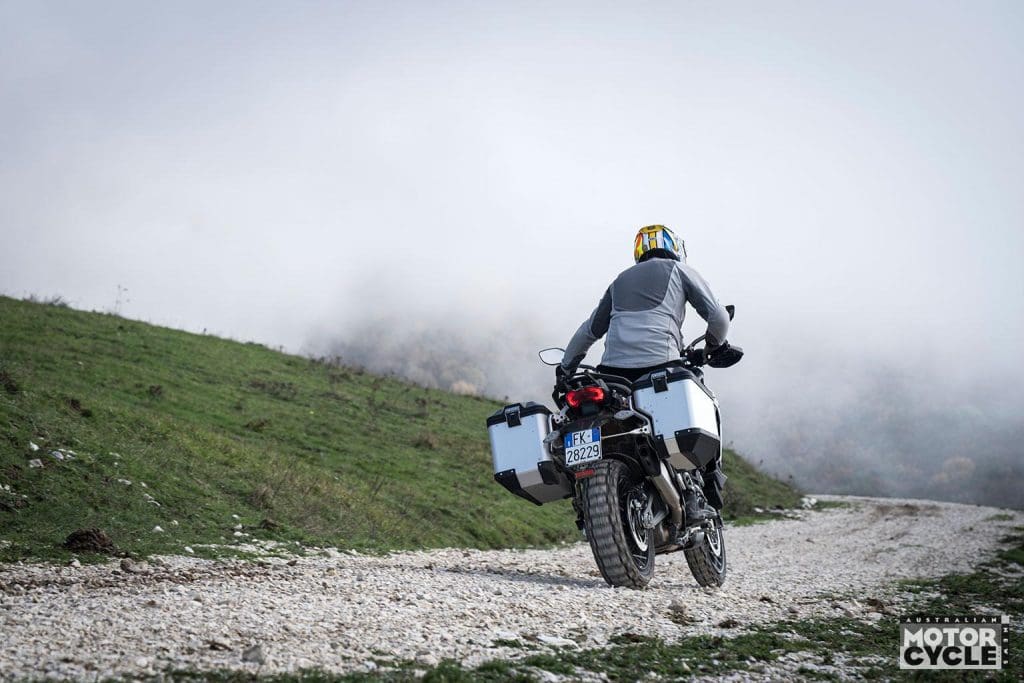
It works perfectly well. The suspension copes with changeable surfaces and for many Ducati owners, knowing their Multi can take on a gravel road with ease and safety will be enough. I found the standard ’bars a little low – they are adjustable but even in the higher position will still be too low for many riders – while the front end pushes a little, and I never really had the confidence to ride aggressively. It’s a stronger dirt prospect than some adventure bikes like the MV Enduro Veloce, but not as competent as the BMW R 1300 GS or KTM Super Adventure.
Specifications

ENGINE
Capacity 1158cc
Type Water-cooled, 4-valves per cylinder four-stroke, 90° V4 Granturismo
Bore stroke 83mm x 53.3mm
Compression ratio 14.0:1
Cooling Water-cooled
Electronic Fuel injection with Ride-by-Wire 46mm elliptical throttle bodies
Transmission Six-speed – Ducati Quick Shift up/down
Clutch Hydraulically activated slipper clutch
Final Shaft Chain
PERFORMANCE
Power 127kw (170hp) @ 10,750rpm (claimed)
Torque 123.8Nm @ 9000 rpm (claimed)
Top speed 165mph (est)
Fuel consumption 6.6L/100km
ELECTRONICS
Rider aids: Riding modes, Power modes, Cornering ABS, Ducati Traction Control, Ducati Wheelie Control, Ducati Cornering Light, Ducati Vehicle Hold Control, Ducati Brake Light EVO.
Rider Modes: Wet Touring, Urban, Sport, Enduro
Frame Aluminium monocoque frame
Rake 24.2°
Trail 100.6mm
Wheelbase 1566mm
SUSPENSION
Front 50mm fully adjustable USD (base) / 50mm electronically fully adjustable Ducati Skyhook Suspension 170mm travel
Rear Fully adjustable, remote preload (base) / Fully adjustable, electronic Ducati Skyhook Suspension 180mm travel
WHEELS & BRAKES
Wheels Light alloy cast.
Front 3. x 19
Rear 4.5 x 17
Tyres Pirelli Scorpion Trail II
Front 120/70 X 19
Rear 170/60 x17
Brakes Ducati Cornering ABS
Front: Brembo monobloc (Stylema on S) radial-mount 4-piston calipers, 320mm discs w/ Cornering ABS
Rear Brembo 2-piston Brembo caliper, 280mm disc w/ cornering ABS
DIMENSIONS
Weight 229kg. (kerb std) 232kg (V4S radar)
Seat height 840-860mm (adjustable)
Width n/a
Height n/a
Length n/a
Ground clearance n/a
Fuel capacity 22L
SERVICING & WARRANTY
Servicing First: 15,000km or 24 month – 60,000km valve check
Warranty 24 months
BUSINESS END
Price $37,900 (as tested)
Colour options Ducati Red, Thrilling Black, Arctic White

